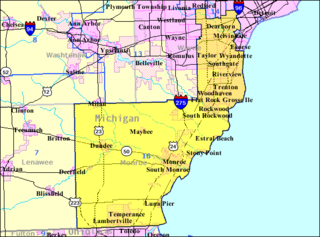Kentucky's 7th congressional district was a district of the United States House of Representatives in Kentucky.
South Dakota's 2nd congressional district is an obsolete district. It was created after the 1910 census and was eliminated as a result of the redistricting cycle after the 1980 census. Members were elected at-large until the formation of individual districts after the 1910 census. From 1913 until 1933, the 2nd district covered much of northeastern South Dakota, including the cities of Aberdeen, Brookings, Huron, and Watertown. When South Dakota's 3rd congressional district was eliminated after the 1930 census, the 2nd district was relocated to cover all of the counties in South Dakota west of the Missouri River. Population changes eventually moved the district's boundaries further east. During the 97th Congress, it covered all but the 21 easternmost counties in the state.
Ohio's 8th congressional district sits on the west side of Ohio, bordering Indiana. The cities of Hamilton, Fairfield, Middletown, Springfield, Eaton, Greenville, Piqua, and Troy are part of the district. The district was represented by Republican John Boehner, the 53rd Speaker of the United States House of Representatives. On September 25, 2015, Boehner announced his resignation from the speakership and retirement from Congress, which became effective on October 31, 2015.
Pennsylvania's 34th congressional district was one of Pennsylvania's districts of the United States House of Representatives. It covered area north of the city of Pittsburgh, Pennsylvania.
Pennsylvania's 31st congressional district was one of Pennsylvania's districts of the United States House of Representatives. It existed from 1903 to 1953.
Pennsylvania's 35th congressional district was one of Pennsylvania's districts of the United States House of Representatives.
Pennsylvania's 33rd congressional district was one of Pennsylvania's districts of the United States House of Representatives.
Pennsylvania's 36th congressional district was one of Pennsylvania's districts of the United States House of Representatives.

Michigan's 15th congressional district is an obsolete congressional district in the state of Michigan.
Pennsylvania's 30th congressional district was one of Pennsylvania's districts of the United States House of Representatives.
Pennsylvania's 29th congressional district was one of Pennsylvania's districts of the United States House of Representatives.
Pennsylvania's 28th congressional district was one of Pennsylvania's districts of the United States House of Representatives.
Pennsylvania's 27th congressional district was one of Pennsylvania's districts of the United States House of Representatives.
Pennsylvania's 26th congressional district was one of Pennsylvania's districts of the United States House of Representatives.
The U.S. state of Pennsylvania elected its United States representatives at-large on a general ticket for the first and third United States Congresses. General ticket representation was prohibited by the 1842 Apportionment Bill and subsequent legislation, most recently in 1967.

Michigan's 16th congressional district is an obsolete United States congressional district in Michigan. It covered the communities of Dearborn, Downriver and Monroe County.
Pennsylvania's 22nd congressional district was one of Pennsylvania's districts of the United States House of Representatives.
Pennsylvania's 24th congressional district was one of Pennsylvania's districts of the United States House of Representatives.
Kentucky's 8th congressional district was a district of the United States House of Representatives in Kentucky. It was lost to redistricting in 1963. Its last Representative was Eugene Siler.
Kentucky's 13th congressional district was a district of the United States House of Representatives in Kentucky. It was lost to redistricting in 1843. Its last Representative was William O. Butler.








